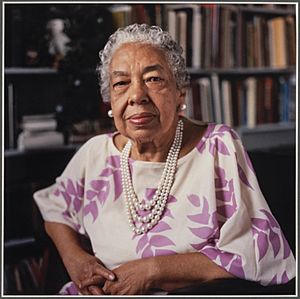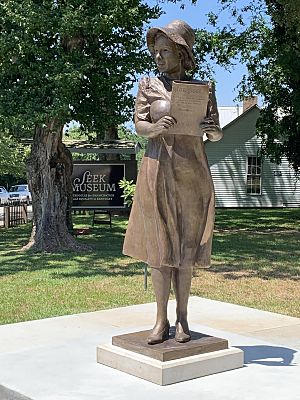Alice Allison Dunnigan facts for kids
Quick facts for kids
Alice Allison Dunnigan
|
|
|---|---|

Dunnigan at her interview for the Black Women Oral History Project
|
|
| Born |
Alice Allison
April 27, 1906 |
| Died | May 6, 1983 (aged 77) |
| Occupation | Journalist and civil-rights activist |
| Known for | First black journalist to cover the White House |
Alice Allison Dunnigan (April 27, 1906 – May 6, 1983) was an American journalist, civil rights activist, and author. She broke barriers for African-American women in journalism. Dunnigan was the first African-American female reporter to get special permission to cover the White House. She was also the first Black woman to join the press groups for the Senate and House of Representatives.
Alice wrote a book about her life called Alice A. Dunnigan: A Black Woman's Experience. She is remembered with a special marker from the Kentucky Historical Society. She wrote about the end of Jim Crow laws in the 1940s and 1950s. This work made her a strong civil rights activist. In 1982, she was added to the Kentucky Hall of Fame.
As a reporter, she was the first Black journalist to travel with a president. She covered Harry S. Truman's 1948 election campaign trip. In 2022, the White House Correspondents' Association created an award in her honor. It is called the Dunnigan-Payne Lifetime Achievement Award. It also remembers fellow White House reporter Ethel Payne.
Early Life and Dreams
Alice Dunnigan was born on April 27, 1906. Her family lived near Russellville, Kentucky. Her parents were Willie and Lena Pittman Allison. Alice's family owned their own land and home. This was unusual for Black families in their area. She and her older half-brother, Russell, grew up in a strict home. They were taught to work hard.
Alice started school at age four, attending one day a week. She learned to read before first grade. At 13, she began writing for the Owensboro Enterprise. Her big dream was to become a newspaper reporter. She wanted to see the world through her writing.
Alice finished Knob City High School. She then studied teaching at Kentucky Normal and Industrial Institute. She became a teacher in the Todd County School System. Schools were separated by race back then. Alice noticed her students did not know about African-American history in Kentucky. So, she wrote "Kentucky Fact Sheets" to teach them more. These sheets were later published as a book in 1982. It was called The Fascinating Story of Black Kentuckians: Their Heritage and Tradition.
Breaking Barriers in Journalism
Alice Dunnigan was known for her direct reporting style. She often asked tough questions about race. Politicians sometimes tried to avoid answering her.
Her journalism career started early, at age 13. She wrote short news items for a local paper. After high school, she went to college to become a teacher. She taught in Kentucky public schools from 1924 to 1942. She married Charles Dunnigan in 1932. They had one child, Robert William.
As a young teacher, Alice taught Kentucky history. She saw that her Black students knew little about their heritage. She created her "Kentucky Fact Sheets" to fill this gap. These papers were finally published as a book in 1982. Teaching did not pay much. So, Alice worked many other jobs during summer breaks. She cleaned houses and did laundry to earn extra money.
In 1942, Alice moved to Washington, D.C. She sought better pay and a government job during World War II. She worked for the government from 1942 to 1946. She also took night classes at Howard University. In 1946, she got a job writing for The Chicago Defender. This was a Black-owned weekly newspaper. The editor paid her less than male reporters at first. She had to prove her skills.
Alice wanted to cover Congress and the Senate. She worked for the Associated Negro Press news service. At first, she was denied access. This was because she wrote for a weekly paper, not a daily one. But six months later, she got her press pass. She became the first African-American woman to get this special access. In 1947, she became the head of the Associate Negro Press office in Washington. She held this important job for 14 years.
In 1948, Alice made history again. She was one of only three African Americans in the press group. She was also one of two women. They followed President Harry S. Truman's campaign trip. Alice paid her own way to be there. That same year, she became the first African-American female White House correspondent. She was also the first Black woman elected to the Women's National Press Club. These roles allowed her to travel widely. She visited places like Canada, Israel, and South America. The President of Haiti even honored her for her articles about his country.
During her time covering the White House, Alice faced many challenges due to racism. She was sometimes not allowed into places to cover President Eisenhower. She had to sit with servants at Senator Taft's funeral. At formal White House events, people sometimes thought she was the wife of a foreign leader. They could not imagine a Black woman attending such an event on her own.
President Eisenhower often avoided calling on her during press conferences. He even asked for her questions beforehand. This was because she asked difficult questions, often about race. No other reporter had to do this. Alice refused to submit her questions in advance. When President John F. Kennedy took office, he welcomed her tough questions. He answered them honestly.
In 1960, Alice left her press job to work for Lyndon B. Johnson's campaign. Johnson became John F. Kennedy's running mate. Kennedy then named Alice an education consultant. She worked for the President's Committee on Equal Employment Opportunity. She stayed there until 1965. She also worked for the Department of Labor and the President's Council of Youth Opportunity. When Richard Nixon became president in 1968, Alice left the White House.
After her White House years, Alice wrote her autobiography. It was called A Black Woman's Experience: From Schoolhouse to White House. It was published in 1974. The book tells her life story. It goes from her childhood in Kentucky to her groundbreaking work in Washington. A new version of her book came out in 2015. It is called Alone Atop of the Hill: The Autobiography of Alice Dunnigan, Pioneer of the National Black Press. She also published The Fascinating Story of Black Kentuckians in 1982.
Alice was most proud of her journalism work. She received over 50 journalism awards. She passed away on May 6, 1983, in Washington, D.C. Two years after her death, she was added to the Black Journalist Hall of Fame.
Monument
A life-size bronze statue of Alice Dunnigan stands in the Alice Dunnigan Memorial Park. This park is in Russellville, Kentucky. The artist Amanda Matthews created the statue. It was first shown at the Newseum on September 21, 2018. After being honored there, it moved to Kentucky. It was also displayed at the University of Kentucky and the Truman Presidential Library.
In August 2019, the statue finally came home to Russellville. It is now a permanent part of the Alice Dunnigan Memorial Park. This park is in the Russellville Historic District. It is also part of the West Kentucky African American Heritage Center.


